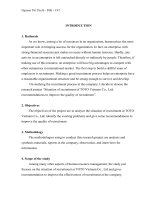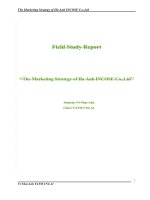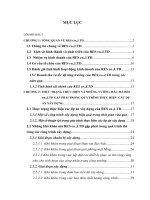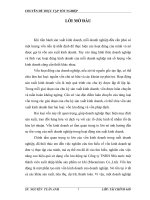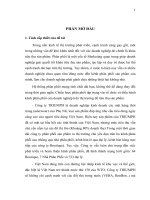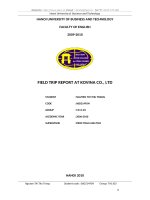enhancing employee motivation at anphanam international co., ltd
Bạn đang xem bản rút gọn của tài liệu. Xem và tải ngay bản đầy đủ của tài liệu tại đây (575.11 KB, 95 trang )
ACKNOWLEDGEMENT
Firstly, I would like to express my gratitude to my supervisor, Associate
Professor Dr. Tran Thi Thu who provided me with quality and friendly advisory
especially and encourage me to finalize this thesis.
I also want to express my special thanks to all professors, doctors, lecturers,
tutors at Business School, National Economics University (BSNEU) who conveyed
me a lot of knowledge, experience in EMBA program, intake 9.
I sincerely thank to all managers and all my colleagues at Anphanam
International Co., Ltd who help me a lot to fulfill the questionnaires and survey, give
me valuable information, advices for implementing my thesis.
Lastly, My sincere thanking goes to my classmates, my parents, my husband
and all my family for their suffering, support, encouragement while studying in the
National Economics University since 2010 and throughout until graduation.
TABLES OF CONTENTS
1.1 RATIONALE 7
1.2 RESEARCH OBJECTIVES 8
1.3 RESEARCH QUESTIONS 9
1.4 RESEARCH METHODOLOGY 9
1.4.1 Research process: 9
Figure 1.1: Research Process 9
1.4.2 Data collection 10
1.4.3 Data Analysis 11
1.5 RESEARCH SCOPE 11
1.6 THESIS STRUCTURE 12
2.1 DEFINITIONS AND ROLES OF EMPLOYEE MOTIVATION 13
2.1.1 Definition of employee motivation 13
2.1.2 Roles of employee motivation 15
Figure 2.1: The needs – Desires – Satisfy Chain 15
2.2 MAIN THEORIES ON EMPLOYEE MOTIVATION 17
2.2.1 Maslow’s hierarchy of Needs 17
Figure 2.2: Maslow’s Hierarchy of needs 18
2.2.2 Herzberg’s Two factor Theory 19
Figure 2.3: Two factors of Needs 21
Figure 2.4: The Interrelation between Needs and Motivation Factors 22
2.2.3 Adam’s Equity Theory 22
Figure 2.5: Adam’s Equity Theory diagram – job motivation 23
3.1 OVERVIEW OF APNI AND ITS CHARACTERISTIC AFFECTING EMPLOYEE MOTIVATION 26
3.1.1 Establishment of APNI 26
3.1.2 Main business fields and development 26
3.1.3 Organizational structure 29
3.1.4 Human resource structure 32
Figure 3.2: APNI’s human resource structure by sex 33
Figure 3.3: APNI’s human resource structure by ages 34
Figure 3.4: Human resource structure by qualification 36
3.2 ANALYZING HYGIENE AND MOTIVATION FACTORS INFLUENCING ON EMPLOYEE MOTIVATION AT APNI
36
3.2.1 Employees’ assessment about the important of hygiene and motivation factors 36
3.2.2 Analyzing the Hygiene factors on employee motivation at Anphanam International Co., Ltd 38
Figure 3.5: The average score of employees’ satisfaction level on working condition 39
44
Figure 3.6: The average score of employees’ satisfaction level on salary and benefit internal equity 44
Figure 3.7: The average score of employees’ satisfaction level on salary and other welfare external
equity 45
Figure 3.8: The average score of employees’ satisfaction level on salary and other welfare with their
contribution 48
Figure 3.9: The average score of employee’s satisfaction level on company policy 52
Table 3.11: Employees’ satisfaction level on supervisor 52
Figure 3.10: Employees’ satisfaction level on the fairness of supervisor in treating with employees 54
Figure 3.11: The average score of employees’ satisfaction level on interpersonal relation 56
3.2.3 Analyzing the motivation factors on Employee motivation at Anphanam International Co., Ltd 56
Figure 3.12: The average score of employees’ satisfaction level on recognition 58
Figure 3.13: The average score of employees’ satisfaction level on performance appraisal 59
Figure 3.14: Employees’ satisfaction level on work itself 62
Figure 3.15: The average score of employees’ satisfaction level on responsibility 65
3.3 SUMMARY OF FINDINGS OF THE RESEARCH ON EMPLOYEE MOTIVATION AT ANPHANAM
INTERNATIONAL CO., LTD 67
3.3.1 The motivation factors 68
3.3.2 The de-motivation factors and reasons 68
4.1 ORIENTATION FOR HUMAN RESOURCE MANAGEMENT OF APNI 72
4. 2 SOLUTIONS AND RECOMMENDATIONS FOR APNI TO ENHANCE EMPLOYEE MOTIVATION 72
4.2.1 Improving working conditions in APNI 72
4.2.2 Adjusting in salary policy 74
4.2.3 Set up a standard and comprehensive recruitment procedure 76
4.2.4 Improving the interesting and challenging work 77
4.2.5 Establishing effective feedback system for managing at APNI 78
4.2.6 Establishing standard performance appraisal system to ensure equity 78
4.2.7 Improving insurance and health policy 79
4.2.8 Improving welfare, other benefit and reward policy and recognition program 80
ABBREVIATION
APNI : Anphanam International Co., Ltd
HRM : Human Resource Management
PA : Performance appraisal
PO : Purchase Order
S&B : Salary and benefit
1
LIST OF TABLES
Table 1.1: Data collecting methods Error: Reference source not found
Table 2.1: Combination of three theories Error: Reference source not found
Table 3.1: APNI’s Human resources structure by sex Error: Reference source
not found
Table 3.2: Human Resource structure by age Error: Reference source not found
Table 3.3: Human resource structure by qualification Error: Reference source
not found
Table 3.4: The important level of Hygiene and Motivation factors Error:
Reference source not found
Table 3.5: Employees’ satisfaction on working condition Error: Reference
source not found
Table 3.6: Employees’ satisfaction on salary and other welfare internal equity
Error: Reference source not found
Table 3.7: Employees’ satisfaction level on salary and other welfare external
equity Error: Reference source not found
Table 3.8: Salary in comparison with other companies. Error: Reference source
not found
Table 3.9: Employees’ satisfaction level on salary and other welfare with their
contribution Error: Reference source not found
Table 3.10: Employees’ satisfaction level on company policy Error: Reference
source not found
Table 3.11: Employees’ satisfaction level on supervisor.Error: Reference source
not found
Table 3.12: Employees’ satisfaction level on the fairness of supervisor in
treating with employees Error: Reference source not found
Table 3.13: Employees’ satisfaction level on interpersonal relation Error:
Reference source not found
Table 3.14: Employees’ satisfaction level on recognition Error: Reference
2
source not found
Table 3.15: Employees’ satisfaction level on performance appraisal Error:
Reference source not found
Table 3.16: Employees’ satisfaction level on work itself Error: Reference source
not found
Table 3.17: Employees’ satisfaction level on challenging, interesting of work
Error: Reference source not found
Table 3.18: Employees’ satisfaction level on autonomy of work Error:
Reference source not found
Table 3.19: Employees’ satisfaction level on responsibility Error: Reference
source not found
Table 3.20: Employees’ assessment about responsibility of employees and
managers when working in group Error: Reference source not found
Table 3.21: Employees’ satisfied level on advancement. Error: Reference source
not found
Table 3.22: Employees’ satisfied level on personal growth Error: Reference
source not found
LIST OF FIGURES
Figure 1.1: Research Process 8
Figure 2.1: The needs – Desires – Satisfy Chain 14
Figure 2.2: Maslow’s Hierarchy of needs 17
Figure 2.3: Two factors of Needs 20
Figure 2.4: The Interrelation between Needs and Motivation Factors 21
Figure 2.5: Adam’s Equity Theory diagram – job motivation 22
Figure 3.1: APNI organization structure 28
Figure 3.2: APNI’s human resource structure by sex 32
Figure 3.3: APNI’s human resource structure by ages 33
Figure 3.4: Human resource structure by qualification 35
Figure 3.5: The average score of employees’ satisfaction level on working condition
3
38
Figure 3.6: The average score of employees’ satisfaction on salary and benefit
internal equity 43
Figure 3.7: The average score of employees’ satisfaction level on salary and
other welfare external equity 44
Figure 3.8: The average score of employees’ satisfaction level on salary and
other welfare with their contribution 47
Figure 3.9: The average score of employee’s satisfaction level on company policy
51
Figure 3.10: Employees’ satisfaction level on the fairness of supervisor in
treating with employees 53
Figure 3.11: The average score of employees’ satisfaction level on interpersonal
relation 55
Figure 3.12: The average score of employees’ satisfaction level on recognition57
Figure 3.13: The average score of employees’ satisfaction level on performance
appraisal 58
Figure 3.14: Employees’ satisfaction level on work itself 61
Figure 3.15: Employees’ satisfaction level on responsibility 64
4
EXECUTIVE SUMMARY
Man is one of the three basic elements to carry out the working process, so
employee motivation plays an important role for the success of a company.
Especially, in today’s competitive environment, to survive and develop,
organizations need to attract talent candidates, reduce labor turnover and increase
productivity by enhancing the motivation of employees. APNI is a medium
company, operating in the fields of trading, import – export and services and gets so
much achievement after 5 years of establishment. However, the employee
motivation at APNI is not good, led to dissatisfaction of employees and low
productivity, even though many of them want to quit job. There were 83%
employees joined the survey, and the result about their satisfaction level is under
satisfied level. From these above reasons, the author has decided to implement the
research on “Enhancing Employee motivation at Anphanam International Co., Ltd”
So, the objectives of the thesis are:
- To synthesize relevant theories on employee motivation with APNI.
- To analyze current situation and find out the main factors motivating as
well as de-motivating employee at APNI.
- To give solutions and recommendations to enhance employee motivation at
APNI.
During the research process, the author conducted in-depth interviews with 9
peoples (in which: 5 employees, 2 managers and 2 ex-employees) and survey 50
respondents at APNI about the relevant issues about enhancing employee
motivation.
The result of the survey shows that the employee motivation at APNI is not
rather good. At APNI, some hygiene factors are not ensured and some motivation
factors are not concentrated on. Salary policy is not good in current salary, salary
5
increasing policy, reward policy. Some working conditions are not good. Welfare
and other benefit policy are lower than many others company. Recruitment policy
and human resource policy is still ineffective and inappropriate. The recognition is
rather bad and unfair. Some time, the work is not really interesting and challenging.
PA policy is not specific and ineffective. Lastly, there are few opportunities for
employees to get promotion in working process at APNI.
Besides, some motivation factors are really good such as office location,
business transportation, security in working place, training program, relationship
between employees as well as employees and managers.
From the finding, the thesis recommended some solutions for APNI to
enhance employee motivation as follows:
- Improving working condition at APNI
- Adjusting in salary policy
- Set up a standard and comprehensive recruitment procedure
- Improving the interesting and challenging work
- Establishing effective feedback system for managing at APNI
- Establishing standard performance appraisal system to ensure equity
- Improving insurance and health policy
- Improving welfare, other benefit and reward policy and recognition
program
The author expects that the research will contribute to the APNI’s human
resource policy and help the manager to recognize and consider more about the
important of “enhancing employee motivation” in developing process of the
company.
6
CHAPTER 1: INTRODUCTION
1.1 Rationale
Human Resources Management always plays an important role in any
organizations. Each organization can only obtain their objects when they have the
employees working enthusiastically, efficiently and creatively. The more
motivations the employees get from the organizations, the more effort they try to
contribution to the organizations.
So, employee motivation is one of the most priority issues of any
organization all over the world as well as Viet Nam. But in fact, many organizations
appreciate employee motivation and gain much more success in implementing all
objectives, while the others do not realize and pay attention on employee motivation
in building up the organization’s overall strategy.
Anphanam International Co., Ltd (abbreviated as APNI) was established in
2007, with headquarters at No. 20, Bo De Street, Long Bien district, Hanoi. APNI is
a small trading company, operating in the field of industrial equipments. The
company specializes in the import of comprehensive industrial machinery and
equipments, industrial consumable materials, industrial chemicals to serve large
factories in industrial zones. Although in the initial establishment, the company
faced many difficulties, but with the efforts of the board of directors and all staffs,
the company has been gradually going up and achieved significant results. Revenue
is growing and the company has become the stable supplier, trusted by many large
customers such as Honda Viet Nam Co., Ltd, Viet Nam Auto Part Co., Ltd, Goshi
Thang Long Auto Part Co., Ltd , Machino Auto Part Co., Ltd, Chinfon Cement Co.,
Ltd, Yamaha Thang Long Co., Ltd, Elentic Viet Nam Co., Ltd and so on.
However, in recent years, it is seem to be the fact that all employee activities
were not really effective. The working atmosphere was very sluggish, tired, and
very passive. There were some employees tried to keep up on the fingerprint mark
timekeeper, after that, they go out for breakfast, café, or do some thing relevant to
7
their self without the consideration about their works. They tried to go to the
company in time just to not be deducted from their salary, not for working purpose.
When encountering difficulties in their work, instead of trying their best to solve
problems, they often relied on the managers. It seems they did not have any
motivation to promote them to work harder, better and more efficiently. The
situation became more alarming, as recently the number employee leaving job was
higher and frequent.
On the other hand, the leader of APNI also have not yet considered about
what factors affecting to employee working behavior at the company. The leaders
focused on business strategy of the company but have forgotten a factor playing a
key role in the successful implementation of the strategy, it is the employees. There
fore, to find out what employees think, need, and what factors can motivate them to
work hard, which is an essential requirements for this period. However, there is no
research conducted in APNI to solve the problems. The author, as an import and
export employee has worked at the company over four years, with my enthusiasm
and dedication, would like to study factors influencing employees’ working
behavior and find out the main factors supporting them work harder and more
effectively. By the research “Enhancing employee motivation at Anphanam
International Co., Ltd” the author showed out the real picture of employee
motivation in APNI and clarified how the motivation factors affects on the working
behavior of the employee and based on that, the author gave out some solutions to
enhance Anphanam’s employee motivation.
1.2 Research Objectives
To synthesize relevant theories on employee motivation with APNI.
To analyze current situation and find out the main factors motivating as well
as de-motivating employee at APNI.
To give solutions and recommendations to enhance employee motivation at
APNI.
8
1.3 Research questions
What are suitable theoretical frameworks on employee motivation at APNI?
What are the factors motivating as well as de-motivating employees at
APNI?
How to enhance employee motivation at APNI?
1.4 Research methodology
1.4.1 Research process:
Figure 1.1: Research Process
Source: Author’s information
9
Research
Objectives
Theoretical
Back ground
Secondary data
(2009 - 2011)
Primary data
In-depth interview ( 9 )
Survey ( 50 )
Data
Collection
Real situation of
Employee motivation
Recommendations
1.4.2 Data collection
The data was collected from two sources: secondary data and primary data as
details as follows:
Secondary data was collected from:
+ Textbooks, journals, magazines and news papers, published researches,
internet, etc.
+ Relevant documents, reports from Accounting Department, Human
Resource Department of the company from 2008 to 2011 such as: quarter report,
year report, Financial Statement, Income Statement.
Primary data was collected by:
+ Qualitative method (In-depth interview): Carried out in-dept interview
with 9 employees: 2 managers, 5 employees and 2 ex-employees.
+ Quantitative method (Survey): The survey was conducted with all
employees and managers in 5 departments. The sample size was 50 and
approximate 83% of the population. The author sent the questionnaires directly to
the respondents and waited for them to receive the results. Types of questions were
close–ended question.
Regarding to the survey, the author designed the questionnaires based on
hygiene and motivation factors and clarified in to five levels, in which:
At level 1: Very dissatisfied
At level 2: Dissatisfied
At level 3: Normal
At level 4: Satisfied
At level 5: Very satisfied
10
Table 1.1: Data collecting methods
Methodology Respondents Purpose
In-depth interviews
5 employees and 2
managers
Factors influencing
employee motivation in
APNI
2 ex-employees
- The main reasons of
leaving APNI
- Comments or
suggestions about APNI’
Human Resource policies.
Survey (questionnaires)
50 employees and
managers
- The real situation of
employee motivation at
APNI
- Assessment about
policies and current
motivation at APNI
Source: Author’s information
1.4.3 Data Analysis
By all the data collected, the author used the quantitative and qualitative
methodologies and illustrated with charts, tables to describe and analyze the
findings and results. The author used Excel to process the data.
1.5 Research Scope
Research Object: Focus on enhancing employee motivation of all employees
at APNI (including all employees and managers of 6 departments). There were 50
employees and managers in 6 departments joined the survey, approximate 83% total
population of the company. There were 9 employees (including 2 managers, 5
11
employees and 2 ex-employees) joined the in-depth interview.
Location: APNI head office – No. 20 Bo De Street, Long Bien Dist, Ha Noi,
Viet Nam.
1.6 Thesis Structure
Chapter 1: Introduction
Chapter 2: Theoretical Framework on employee motivation
Chapter 3: Current Situation of employee motivation at Anphanam International
Co., Ltd
Chapter 4: Solutions and recommendations to enhance employee motivation at
Anphanam International Co., Ltd
CHAPTER 2: THEORETICAL FRAMEWORK ON
EMPLOYEE MOTIVATION
12
2.1 Definitions and roles of employee motivation
2.1.1 Definition of employee motivation
Motivation
What is motivation? Motivation is difficult to explain and even harder to
“turn on” in people. Many people said that motivation as an act or process of
motivating; the condition of being; a force, stimulus, or influence: incentive or
drive? There are many definitions of motivation, each of them to description as a
side of the issue such as:
"Motivation”, in psychology, is the intention of achieving a goal, leading to
goal-directed behavior. Some human activity seems to be best explained by
postulating an inner directing drive. While a drive is often considered to be an
innate biological mechanism that determines the organism's activity (see instinct), a
motive is defined as an innate mechanism modified by learning."
(Source: Motivation, Columbia Electronic Encyclopedia - Columbia
University Press November 08, 2007).
“Motivation is defined as the desire or aspiration of people for achieving a
goals combined with the effort to work towards the organization goals”.
(Source: Dr. Nguyen Van Diem and Dr. Nguyen Ngoc Quan – Human
Resource Management – National Economics University – 2007).
But according to the Business Edge (2005), Work motivation , Ho Chi Minh
said “Motivation is positive process that implied conscious and unconscious
actions make a person take action and simulate him to reap his achievements”.
There are two basic types of Motivation: intrinsic and extrinsic motivation
Intrinsic motivation: reflects the desire to do something because it is
enjoyable. If we are intrinsically motivated, we would not be worried about
13
external rewards such as praise or awards. If we are intrinsically motivated, the
enjoyment we experience would be sufficient for us to want to perform the activity
in the future.
Extrinsic motivation reflects the desire to do something because of external
rewards such as awards, money, and praise. People who are extrinsically motivated
may not enjoy certain activities. They may only wish to engage in certain activities
because they wish to receive some external reward.
Motivating employees:
According to Mr Nguyen Khac Vien (1995), psychology dictionary, World
edition, Ha Noi: “Motivating is positive processes that implied conscious and
unconscious actions make a person take action and stimulate him to reap his
achievements”.
Besides, many people think that motivating means stimulating somebody to
tack action by putting his desirable goals. Motivating like a mean that urges and
encourages somebody to work harder and more effectively. So, for every leader,
understanding employee’ feeling is very important.
Standing on the point view of managers, some people think that they can
encourage their employees and make them more concerned and more involved in
achieving the goals of his organization. But some ideas insist that if the manager
pays the employee more money, they are motivated and committed themselves and
working harder. This way of thinking maybe right but sometime it may be wrong on
account of the difference needs and desires between different employees.
In general, managers should understand their employee’s need and feelings.
They have to identify which ones will be motivation for their employees. But in
fact, needs and desires will be changed overtime and environment. So, in addition to
understanding employees’ needs and desires, managers should timely satisfy them.
14
2.1.2 Roles of employee motivation
The definition of needs is very different with different people, and needs was
clarified into many levels. The lowest level of needs is physical survival needs or
basic need such as water, food, sleep, health, exercises, and the higher levels are
needs for safety and security, social needs and belonging, need for self esteem and
the highest level is need for self actualization. The fact that, every body tends to
reach needs form lowest level to highest level. As the result, their behaviors will be
changed because of the desire of satisfying those needs, and further more they will
try to work harder and more effectively.
The needs of people never stop, and always change from lowest level to
highest level. When one of the needs is satisfied, other higher need will exist. At
this time, a satisfied need is not a motivator, new demand will be appear. So, the
needs are quite huge in life.
According to Harold Koontz, Cyril Odonell, Heinz Weihrich (1994), the
needs- desires – satisfy chain was described as follows:
Figure 2.1: The needs – Desires – Satisfy Chain
(Source: Harold Koontz, Cyril Odonell, Hein Weihrich (1994), Core Issues of
Management, Science and Technology Publishing House, Ha Noi)
The needs of each person is very different, because they live in different
environments, different characteristics and circumstances in which the
environment is one important factor that affects directly. When one person
works in a large organization, professional working environment, but full of
competition, at high position, the environment will affect him so much. It gives
him a lot of challenge, and motivates him to try to complete all the tasks
involved, and also encourage others in the organization. So, the need is the
15
Satisfy
Needs Desires Stress
Actions
cause and effect of behavior systems because satisfying the need will be the
motivation for another need and event to another person.
- With employees:
As you know, jobs play an important role in our life, and of course we spend
a lot of time for jobs. Every one has their own objectives for life and they will set
up the plan to achieve their own objectives. If people work in a good condition,
have motivation from managers, colleagues, workers, they will get a very good
result. Further more, an employee always try to achieve goals, means get success.
And then, the success will be the motivation help them overcome all difficulties and
obstacles if life.
- With the organization:
Firstly, employee motivation puts human resources into action. Every
concern requires physical, financial and human resources to accomplish the goals. It
is through motivation that the human resources can be utilized by making full use of
it. This can be done by building willingness in employees to work. This will help
the enterprise in securing best possible utilization of resources.
Secondly, employee motivation improves level of efficiency of employees.
The level of a subordinate or an employee does not only depend upon his
qualifications and abilities. For getting best of his work performance, the gap
between ability and willingness has to filled which helps in improving the level of
performance of subordinate, it will help the organization to increase in productivity,
reduce cost of operating and improve overall efficiency.
Thirdly, employee motivation leads to achievement of organizational goals.
It brings to the organization some issue such as: the best possible utilization of
resources, co-operative work environment, the employees are goal – directed and
the act in a purposive manner. The goals of an enterprise can be achieved only when
the above factors take place. Further more, goals can be achieved if co-ordination
16
and co-operation takes place simultaneously which can be effectively done through
motivation.
Fourthly, employee motivation builds friendly relationship: Motivation is an
important factor which brings employee satisfaction. This can be done by keeping
into mind and framing an incentive plan for the benefit of the employees. This
could initiate the following things: monetary and non-monetary incentives,
promotion opportunities for employees, disincentives for inefficient employees. In
order to build a cordial, friendly atmosphere in a concern, the above steps should be
taken by a manager.
Fifthly, employee motivation leads to stability of work force. From the point
of view of reputation and goodwill of a concern, stability of workforce is very
important. The employees can remain loyal to enterprise only when they have a
feeling of participation in the management. The skills and efficiency of employees
will always be of advantage to employees as well as employees. This will lead to a
good public image in the market which will attract competent and qualified people
in to a concern.
- With the society:
When organizations attract many employees to work and help them get
success at works, this brings benefits to employees, organizations as well as the
society. It can create more jobs for people, reduce unemployment, increase social
welfare, and eliminate socials evils. When employees are motivated, they will work
harder, effectively, and try their best to contribute to the development of
organizations, and further more, can built up a society of development and
prosperity.
2.2 Main theories on employee motivation
2.2.1 Maslow’s hierarchy of Needs
17
Figure 2.2: Maslow’s Hierarchy of needs
(Source: www.businessballs.com)
Maslow’s hierarchy of Needs identities five levels of Needs, which are:
Physiological needs, Safety needs, Social needs, and Esteem needs and Self-
actualization needs. This theory said that when the needs of each of these needs are
met, the next demand will become more important. Satisfying the needs of the
individual will go on and hierarchical as though no one needs that can be fully
satisfied, but when a need is satisfied basically, it no longer created motivation.
Thus, according to Maslow, in order to create motivation for employees, managers
need to understand where the employee is in the hierarchy and direction to the
satisfaction of that needs level.
Level 1: Physiological needs are the most basic human needs. They include
food, water, sleep, warmth, health, exercise, sex. To satisfy this need, the
organizations can provide by a paycheck.
Level 2: Safety needs are described for security and safety, including:
personal security, economic security, freedom from threats, comfort, and peaces. To
satisfy this need, the organization can provide employees by benefits.
Level 3: Social needs are described for affiliation. They include friendship
18
and belonging. This need can be satisfied by sport teams, group membership,
parties, and celebrations, association. The supervisor can help fulfilling social needs
by showing direct care and concern for employees.
Level 4: Esteem needs are described for self-respect and respect or
recognition from others. By matching the skills and abilities of the employee to the
job, the manager can help employees to satisfy this need level. The supervisor can
help fulfilling esteem needs by showing employees that their work is appreciated.
Level 5: Self – actualization needs are described for self-fulfillment and the
realization of individual’s full potential such as challenge projects, opportunities for
innovation and creativity, learning at high level. The supervisor can help fulfill self
actualization needs by assigning tasks that challenge employees’ minds while
drawing on their aptitude and training.
2.2.2 Herzberg’s Two factor Theory
Herzberg divided the elements that make up the satisfaction and
dissatisfaction in the work into two groups: hygiene factors and motivator factors:
2.2.2.1 Hygiene factors
- Company policy and management style: including human resource policy,
financial policy, and administrative procedure. It firstly and directly affects the
employee in organization
- Supervisor: this factor includes the fairness and unfairness of the
supervisors, the willingness or unwillingness to delegate responsibility or to train
their staffs
- Salary: the factor involve in current salary, payment salary and salary
increment policy. It should be appropriate and reasonable.
- Interpersonal relations–supervision: including the relationship of
employees with peers, supervisors and subordinates. It should not be conflict and
humiliation.
- Working condition: mean physical conditions of work such as office
equipment, working room and stationeries.
19
2.2.2.2 Motivation factors
- Recognition: This is one of major criteria that source could be almost every
one: supervisor, managers, a client, a peer, a professional colleague or general
public.
- Work it self: involve in the feeling of the employee about the job. So, job
can be routine or carried, creative or studying overly easy or overly difficult.
- Achievement: including successfully completion of a job or aspect of it,
having a good idea or solution to problems, made more money for the company,
vindication and seeing the result of one’s work.
- Possibility of growth: including not only the likelihood that the individual
would be able to move onward and upward within his organization but also a
situation in which he or she is able to advance in his or her own skills and
profession.
- Advancement: related to actual change in the status or position of a person
in the company.
- Responsibility: including the events in which the employee derived or lost
satisfaction from being given responsibility for his or her own work of others of
being given new responsibility.
From this research, Herzberg suggested a two-step approach to
understanding employee motivation and satisfaction: first, provide hygiene and then
motivator. Hygiene range from no satisfaction- to satisfaction while range from
dissatisfaction to no dissatisfaction.
20
Figure 2.3: Two factors of Needs
(Source: Work an the Nature of Man, Crowell Publication 1966)
Satisfaction comes from motivators that are intrinsic or job content, such as
achievement, recognition, advancement, responsibility, the works itself, and growth
possibilities. Herzberg uses the term “motivators” for bob satisfiers since they
involve job content and the satisfaction that results from them. Motivators are
considered job turn on. They are necessary for substantial improvement in work
performance and move the employee beyond satisfaction to superior performance.
Motivators correspond to higher level needs of esteems and self actualization.
Dissatisfaction occurred when hygiene factors extrinsic or job content such
as pays, status, job security, working condition, company policies, peer relation and
supervision are not present on the job. Herzberg uses the term “hygiene” because
they are preventive in nature. They will not produce motivation but they can reduce
de-motivation from occurring. Hygiene factors can be considered job stay on
because they encourage an employee to stay on the job. When these factors are
provided, they do not necessarily promote motivation but their absence can create
employee dissatisfaction. Hygiene factors correspond to physiological, safety and
21
social needs in that they are extrinsic, or peripheral to the job. They are present in
working environment of job content.
Motivation comes from the employee’s feeling of accomplishment or job
content rather than from the environmental factors or job content. Motivators
encourage an employee to strive to do his or her best. Job enrichment can be used to
meet higher-level needs. To enrich a job, a supervisor can introduce new or more
difficult tasks, assign individuals specialized tasks that enable them to become
experts, or grant additional authority to employees.
Thus, we can compare the interrelation between Maslow’s Hierarchy of
Needs and herzberg’s Motivation Hygiene Theory as follows:
Figure 2.4: The Interrelation between Needs and Motivation Factors
(Source: Harold Koontz, Cyril Odonell, Heinz Weihrich (1994), Core issues
of Management, Science and Technology Publishing House, Ha Noi).
2.2.3 Adam’s Equity Theory
Equity theory is a model of motivation that explains how people strive
for fairness and justice in social exchange or give-and-take relationships.
22


